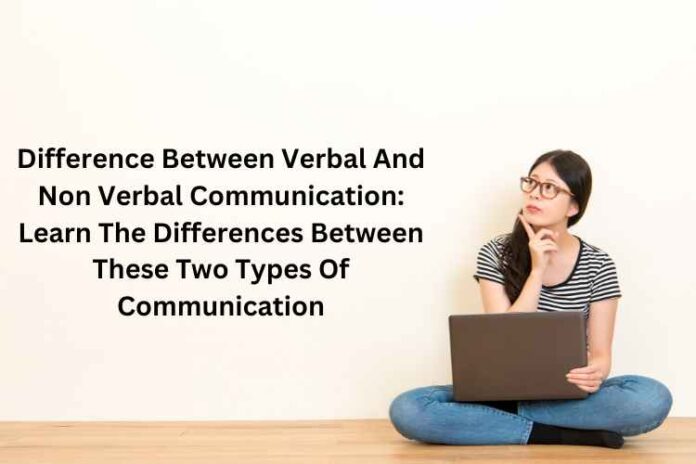Communication is a two-way process that refers to sending and receiving messages by verbal and non-verbal means. There are many other methods of communication, but the two most important ones are verbal and nonverbal. The main difference between verbal and nonverbal communication is that verbal communication is mostly based on words whereas, nonverbal communication such as gestures, expressions, and body language also play an important role. The contrast that exists between verbal and nonverbal communication aids in effectively delivering messages, affecting interactions, and forming our comprehension of one another.
In this article, we have shared the difference between verbal and nonverbal communication along with the difference between verbal and nonverbal communication with example that will help you understand their importance in effective communication easily.
What is Verbal communication?
Verbal communication is the act of expressing thoughts, facts, and emotions to another through spoken words and vocal noises. In other words, It entails using language to have discussions, exchange experiences, and express thoughts. People may convey their ideas, beliefs, and feelings verbally, which promotes connection and understanding between one another.
To convey information, make decisions, and develop connections, verbal communication is essential in daily life. It includes not only the uttered words but also the tone, pitch, and intonation, which give the message being given additional layers of depth and significance.
What is non-verbal communication?
The exchange of information, sentiments, and meaning without the use of spoken or written words is known as nonverbal communication. In non-verbal communication visual signs such as communication of ideas, gestures, facial expressions, body language, tonality, and other visual signals are used. These nonverbal signs frequently convey feelings, attitudes, and intentions that either support or defy spoken words.
As it can emphasize, reinforce, or change the meaning of vocal signals, nonverbal communication is essential for comprehending and interpreting social interactions. Understanding and interpreting nonverbal signals improves efficient communication and assists people in navigating social settings more effectively.
Verbal And Non-Verbal Communication- Difference With Examples
In verbal communication, messages are communicated through words and language. Or we can say that it occurs when we speak or write to convey information, thoughts, and ideas. Verbal communication includes things like having a chat with a buddy, speaking, and sending text messages.
On the other hand, nonverbal communication involves expressing ideas without using words. It encompasses body language, vocal inflection, gestures, facial expressions, and even eye contact. Nonverbal cues include things like smiling to express joy, nodding in agreement and crossing one’s arms to signify defensiveness.
Despite the difference between verbal and nonverbal communication, both forms an integral part of communication. Accurate meanings can be communicated and improved communication can result from an understanding of and efficient use of verbal and nonverbal communication.
Difference Between Verbal And Non-Verbal Communication With Examples Skills
Verbal communication involves exchanging information, ideas, and thoughts using spoken language. In addition, it comprises listening, speaking, and writing. Clear communication, attentive listening, and good word choice are all aspects of effective verbal abilities. Verbal communication skills include things like drafting emails or expressing a concept in a meeting.
Without using words, nonverbal communication focuses on conveying meaning and emotions. In addition, It comprises gestures, tone of voice, facial expressions, and body language. Accurate emotion and purpose communication is aided by strong nonverbal communication. Keeping eye contact, speaking in a cordial tone, and nodding in agreement are some skills of nonverbal communication.
As they together make for effective communication, as a result, a speaker’s nonverbal and verbal cues need to coordinate. While smiling and making gestures, someone may show that they are excited. Enhancing comprehension and fostering stronger connections require attention to both areas. As a result, developing verbal and nonverbal communication skills is crucial for effective relationships.
Difference Between Verbal And Non-Verbal Communication In Table Format
| Basis of Difference | Verbal Communication | Non-Verbal Communication |
| Definition | It involves the use of words, speech, or writing to convey the message. | It involves the use of body language gestures and facial expressions etc. without using words. |
| Content | It conveys explicit information and can be precise as well. | It conveys emotions, attitudes, and context. |
| Language Barrier | The issue of a language barrier can occur if the languages of both parties differ. | In nonverbal communication, language barriers can be transcended to some extent. |
| Emotional expression | The tone of voice can convey expressions in verbal communication. | It expresses emotions directly through facial expressions and gestures. |
| Importance in conflicts | Verbal arguments may escalate easily. | Nonverbal communication may influence the tone and outcome of conflicts. |
| Speed of Delivery | In verbal communication, the speed of delivery can be fast depending on the speaker. | In non-verbal communication, the speed of delivery can be instantaneous and simultaneous with verbal communication. |
| Clarity | In verbal communication there that clarity in conveying specific information | Non-verbal communication adds depth and nuance to the message but may be open to interpretation. |
| Formality | There is a lot more formality in verbal communication. | There is less or no formality in non-verbal communication. |
| Types | There are two types of verbal communication i.e., written and oral. | The various type of nonverbal communication includes audiovisuals, visuals, audio and silent, etc |
| Purpose | The purpose of verbal communication may be to influence or persuade others with logical arguments | The purpose of nonverbal communication may be to build emotional connection and trust among others. |
FAQs
What is verbal communication?
Ans. Using spoken words to communicate ideas, thoughts, or facts to another is known as verbal communication. It is a method of conveying ideas through speech, dialogue, or conversation. To understand and respond effectively, effective verbal communication requires clear expression and active listening.
What is nonverbal communication?
Ans. Speaking without using words is known as nonverbal communication. To express sentiments, emotions, or thoughts, gestures, facial expressions, body language, and tone of voice are used. Nonverbal cues can support spoken words or contradict them, which is important for deciphering and comprehending interpersonal communication.
How do verbal and nonverbal communication differ?
Ans. The key point of difference between verbal and nonverbal communication is the usage of spoken or written words to convey messages in one and gestures, expressions, and body language in the other. Though nonverbal communication can also convey information, verbal communication is more plain and straightforward. To transmit full meanings and improve understanding in interactions, both forms work best when used in combination.
Which is more important, verbal or nonverbal communication?
Ans. There are various points of difference between verbal and nonverbal communication however both play an important role in effective communication. Words provide information, whereas gestures and facial expressions convey meaning and emotions. According to the circumstance, nonverbal communication may be more significant than verbal communication in expressing a person’s true feelings.
What are some examples of verbal communication?
Ans. Speeches, lectures, interviews, presentations, and phone calls are all examples of verbal communication. It entails using spoken or written words to communicate with others, share information, and express ideas.
RELATED – IS KRIVATORY WEBSITE REAL OR FAKE?
The Final Words
Even though there are several differences between verbal and nonverbal communication, both are essential threads sewn into the fabric of human contact. Together, they create a dynamic tapestry of expression that they each contribute to, clarify, and occasionally even contradict. Understanding and mastering this interaction enables us to have more insightful talks and build stronger relationships.
We hope that you found this article informative and now you know the difference between verbal and nonverbal communication with example skills along with their importance in effective communication.
Popular Search Terms
Is Krivatory Website Real or Fake?, Cgmix Gaming App Review, Smitesource, ENWARE AREA51 THREADRIPPER, What Is The Difference Between Cavapoo & Cavoodle?, Running a Money.






















